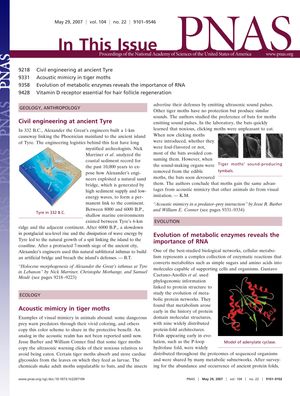In This Issue

TLDR Alexander the Great's engineers built a causeway using a natural sand bridge, some tiger moths avoid bats by mimicking toxic relatives' sounds, early metabolism and RNA enzymes support the ancient RNA world theory, and vitamin D is crucial for hair growth and its absence can cause baldness.
In a 2007 issue of PNAS, several studies were highlighted. Marriner et al. revealed that Alexander the Great's engineers utilized a natural sand bridge to construct a 1-km causeway to the island of Tyre in 332 B.C. Barber and Conner discovered that some tiger moths use acoustic mimicry to avoid predation by bats, mimicking the ultrasonic warning clicks of noxious relatives. Caetano-Anollés et al. studied the evolution of metabolic enzymes and found that metabolism and enzymes involved in RNA synthesis were established early in evolution, supporting the concept of an ancient RNA world. Cianferotti et al. demonstrated that the vitamin D receptor is essential for the regeneration of hair follicle stem cells, working through the Wnt signaling pathway, and its loss can lead to alopecia. This research provides insights into ancient engineering, predator-prey interactions, the evolution of metabolism, and the biology of hair growth.




